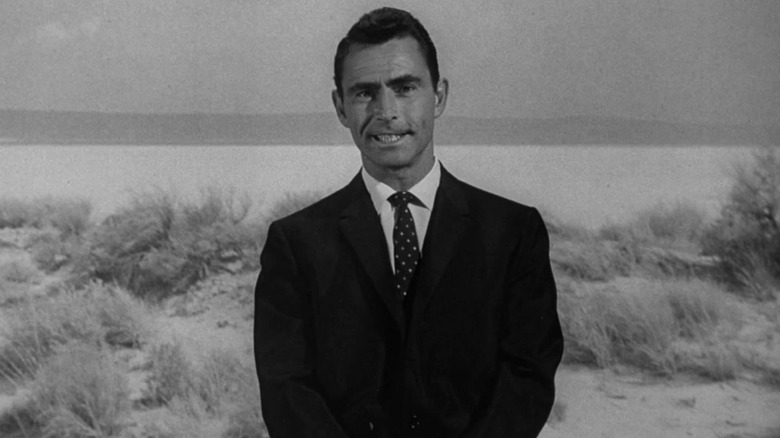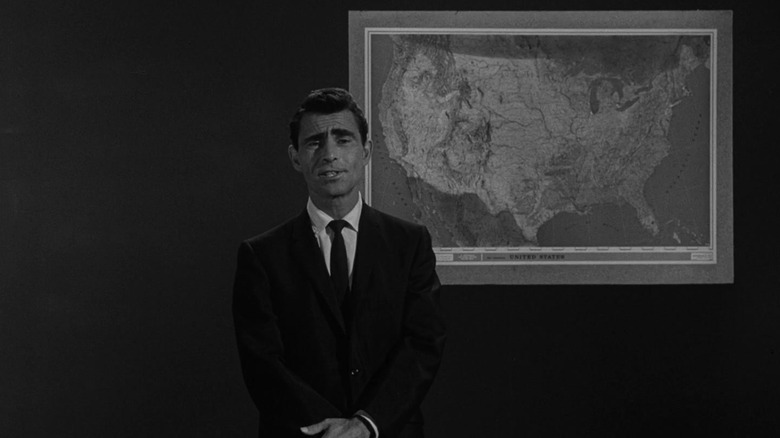Every single episode of the 1959 speculative anthology series “The Twilight Zone” was introduced by series creator and head writer Rod Serling. Throughout the show’s first season, Serling merely provided a voice narration, but beginning with the second, he appeared on-screen as well, always sporting a nice suit and often smoking a cigarette.
Serling, as it turns out, never wanted to be the narrator for “The Twilight Zone.” As previously reported by /Film, Orson Welles was to be hired to provide the show’s narration. Welles, of course, had a prolific career on radio in the 1930s, about a decade before he made the jump to films, so his crisp, sonorous voice was well-rehearsed. CBS wanted Welles not just for his fame, but because his presence would invite comparisons to CBS’s successful 1955 anthology series “Alfred Hitchcock Presents.” That show featured on-screen introductions from Hitchcock himself, so it stood to reason that another film legend should introduce “The Twilight Zone” (even if Welles had nothing to do with the production of “The Twilight Zone.”
Of course, in order to hire Welles, CBS would have had to shell out a tidy salary for the filmmaker, and, well, they just couldn’t afford to. CBS then pivoted to a new narrator, an actor named Westbrook Van Voorhis, who actually narrated the opening segments for the original “Twilight Zone” pilot “Where Is Everybody?” Van Voorhis was best known at the time for narrating newsreels and documentaries, so his voice would be comforting to viewers.
The producers of “The Twilight Zone,” however, felt that Van Voorhis sounded too pompous. With time running out on production, Serling was forced to step in at the last minute. CBS thought this was fine, as they wouldn’t have to negotiate any new contracts.
Serling hated it. He confirmed as much in a 1963 interview with the Sacramento Bee, handily transcribed by MeTV.
Rod Serling had to step in at the last minute … and he hated it
One of Serling’s main issues with appearing on-screen boiled down to simple vanity; he hated the way he looked. He was sharply aware of his physique and height. His wife also didn’t do much to assuage his nerves. Serling said:
“My wife says I come over on the television screen looking like a constipated prizefighter. […] That’s because there’s nothing on camera with me to compare me with. But there I am, five feet, five inches of solid gristle. I really don’t like to do the hosting. I do it by default. I have to.”
Incidentally, Serling competed as a flyweight boxer in the 1940s when he was training to be a paratrooper. He was even known for his “berserker” style of fighting. It seems that he looked at his own body as a boxer’s body … and was insecure about what he saw. He was also uncomfortable with acting; he preferred writing and producing, hoping to hand off acting duties to a rotating roster of known faces. Going in front of cameras, Serling admitted, gave him an attack of nerves. He continued his fight metaphors, saying:
“I just tense up terribly before going before the cameras. […] If I had to go on live, of course, I’d never do it. It’s like boxing, I’m the only fighter in history who had to be carried both into and out of the ring.”
Serling also acknowledged in the same interview that fame was fleeting. He had a hit show on his hands with “The Twilight Zone,” but there was every reason to believe that he would be forgotten the following year. Which he was fine with; he liked anonymity. Serling, who passed away in 1975, couldn’t have predicted the lasting impact his show would have on the culture at large, however, or how well he would be remembered.
“The Twilight Zone” was revived in 1985, 2002, and 2019, and is re-watched to this day.









